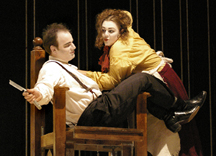Oct. 29, 2009
Regents approve budget reversion plan
by Anne Krapfl
Employees, students and university units likely will share the burden of a mid-year reduction of $24.5 million in state funding, under a plan approved by the state Board of Regents today. Regents Michael Gartner, Ruth Harkin, Greta Johnson and Craig Lang expressed opposition to the tuition surcharge component in the proposal. However, the tuition surcharge proposal actually is a separate agenda item and the board won't officially vote on that piece until its December meeting.
As outlined by president Gregory Geoffroy, four university-wide initiatives will generate the first $12 million in revenue or savings at Iowa State. These are:
A temporary layoff/furlough plan for all employees, graduated by salary level, which will generate approximately $7 million in savings. For full-time 12-month employees, the breakout looks like this:
Annual salary Layoff/furlough days $60,000 or less 4 days $60,001-$120,000 6 days Above $120,000 8 days 26 administrators 10 days President Geoffroy 12 days For employees working less than full time or less than year-round, the number of days will be adjusted proportionately.
A 20 percent temporary reduction (from 10 to eight percent of an employee's salary) in the university's contribution to employees' TIAA/CREF retirement accounts for the remaining eight months of this fiscal year. This will generate approximately $2.6 million in savings.
A second retirement incentive plan (RIO). Eligibility is open to employees at least 57 years old with at least 10 years of service. Employees must apply for the option by March 31, 2010, and retire from the university by July 30, 2010. Geoffroy said most of the impact on budgets of this option would be felt next fiscal year.
-
If it's approved in December, a $100 tuition surcharge to students for spring semester will generate approximately $2.4 million based on a projected 24,000 student FTE. The surcharge will be pro-rated for part-time students based on semester credit hours, $18-$99 for undergraduates, $24-$96 for graduate students. The additional tuition will be distributed to the academic colleges.
Geoffroy said savings realized from the retirement contribution reduction and temporary layoffs or furloughs would be credited to the departments where the employees work. The remaining $12.5 million in cuts will be distributed among the vice presidents and president's units, where leaders there will make decisions to meet the reversion. Geoffroy said there has been time only for "quick analysis," but estimated that identifying that amount may look something like this:
$4.1 million in fall tuition above what was budgeted
$4.1 million in operating expense savings, including travel, equipment purchases and a partial shutdown of the university from Dec. 24 to Jan. 3
$3.3 million in personnel savings, including delaying hires, eliminating vacant positions and transferring compensation costs to other funds such as contracts and grants
$1 million in program reductions, including support for centers and institutes and campus services (such as facilities planning and management and environmental health and safety)
If the board doesn't approve the spring tuition surcharge, Geoffroy said that $2.4 million would be added to the reduction targets distributed among Iowa State units.
The latest
The Budget Updates page provides the latest info on ISU's budget.
Endorsements
Faculty Senate president Arnold van der Valk told the board that Iowa State faculty support the "progressive furlough plan," "reluctantly support" the tuition surcharge because they see no other short-term alternatives, and oppose the reduction to TIAA-CREF contributions. He said the short-term gain from the benefit reduction is "more than offset by the long-term harm."
van der Valk said Iowa State's poor standing among peer schools in faculty salaries is offset slightly by a strong benefits package. Tampering with it harms Iowa State's recruitment of excellent faculty and also forces current faculty to work longer before they can retire. This in turn delays the hiring of new faculty who bring new ideas to the university.
Professional and Scientific Council president Camille Schroeder presented highlights of the council's survey last week. In it, she said P&S employees expressed a preference for: temporary furloughs over permanent layoffs, temporary over permanent benefits reductions, length of furlough based on salary size, and furloughs/temporary layoffs for all employees, not just P&S staff. P&S staff also supported the lower age (57 years) for the RIO.
Danny Homan, president of the Iowa chapter of the American Federation of State, County and Municipal Employees (AFSCME), which represents most Iowa State merit employees, said his top priority is to save jobs. He said AFSCME employees already "are doing more with less." He pushed the board for more frequent communication with union leaders and encouraged them to "use our ideas for real cost savings."
"Give us a real seat at the table, not a token seat," he said.
Jonathan Turk, Government of the Student Body president, said he can't support the impact of the tuition surcharge on students, but recognizes that it may preserve quality of education for students as well as jobs at Iowa State. He also spoke against the proposed tuition increase for 2010-11. He said it's considerably beyond the projected Higher Education Price Index median of 2.7 percent, a figure the board tries to use as a guideline in setting tuition.
Geoffroy declines bonus
In another discussion, Geoffroy also told the board he would not accept the performance-based part of his compensation this year, which can be up to 12 percent of his annual compensation of $423,316. He asked the board generally to consider other compensation structures, saying he doesn't like the concept of performance bonuses for public officials.
"It creates enormous public relations issues. In these economic times, it's especially not wise," he said.
